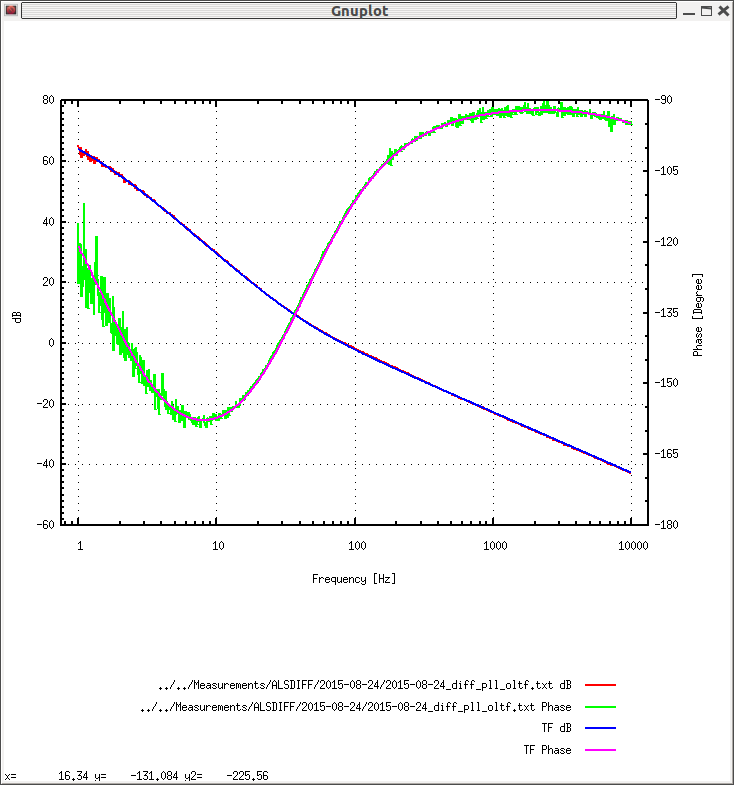J. Kissel
For efforts of limiting systematics in the calibration, I've measured all ISC controlled stages of ETMY drivers, UIM, PUM, and TST. For now, I just attach screen shots of the measurements and report where they live, such that LLO might repeat exactly the same measurements tomorrow (instead of their current plan to take the measurements in analog, lugging around an SR785). In the fullness of time, I'll fit these to get precise poles and zeros for use in the DARM model.
I can already tell that they will be different from what has been quoted as cannon -- LLO aLOG 4495 -- which is upon what all ETM current *coil* driver compensation filters are based. For example, for some reason, the z:p = 50:300 [Hz] filter on the output impedance network of the UIM drivers, seems to have disappeared. It was supposed to have moved up in frequency when we increased the drive strength (see T1400223 and E1400164) but not disappear. It shouldn't matter for the calibrating, but this is just rediculousness that should be investigated lest we're being misinformed about the frequency region we do care about by a bogus measurement.
Anyways, I'll do a similar study to what was done in LLO aLOG 4495 with this data, and we will compensate the calibration accordingingly.
Details:
------------------
In order to
(1) speed up measurements
(2) focus drive amplitude and number of cycles in the frequency regions which were needed, and
(3) yield the ability to do multiple slow measurments simultaneously
I split the measurements for each driver into several templates with differing frequency bands. Ideally, if I weren't inventing, completing, and hoping to analyse it all to give me a very precise result in one day, I would have used the SEI group's Schroeder-phased TF tool, which has such flexibility, but alas.
The templates live and have been committed to here:
/ligo/svncommon/CalSVN/aligocalibration/trunk/Runs/ER8/H1/Measurements/Electronics/
For ESD Driver in low-noise configuration:
2015-08-24_H1SUSETMY_ESDLVLNDriver_WhiteNoise_0p5Hzto1kHz_$(QUADRANT)_TF.xml
2015-08-24_H1SUSETMY_ESDLVLNDriver_SweptSine_50Hzto1kHz_$(QUADRANT)_TF.xml
2015-08-24_H1SUSETMY_ESDLVLNDriver_SweptSine_500Hzto7kHz_$(QUADRANT)_TF.xml
For ESD Driver in high-range configuration:
2015-08-24_H1SUSETMY_ESDHVDriver_WhiteNoise_0p5Hzto1kHz_$(QUADRANT)_TF.xml
2015-08-24_H1SUSETMY_ESDHVDriver_SweptSine_50Hzto1kHz_$(QUADRANT)_TF.xml
2015-08-24_H1SUSETMY_ESDHVDriver_SweptSine_500Hzto7kHz_$(QUADRANT)_TF.xml
For PUM Driver (each template covers all quadrants)
2015-08-24_H1SUSETMY_PUMDriver_SweptSine_0p1to30Hz_$(FILTERSTATE)_TF.xml
2015-08-24_H1SUSETMY_PUMDriver_WhiteNoise_1to7000Hz_$(FILTERSTATE)_TF.xml
For UIM Driver (each template covers all quadrants)
2015-08-24_H1SUSETMY_UIMDriver_WhiteNoise_0p1to900Hz_$(FILTERSTATE)_TF.xml
2015-08-24_H1SUSETMY_UIMDriver_WhiteNoise_0p1to7000Hz_$(FILTERSTATE)_TF.xml
Regarding the system set-up, I took advantage of the secret coil driver switching ability (revealed in, for example, on page 8 of G1401184), to turn off the digital compensation filters, and drove through the either the ESDOUTF bank for L3/ESD or the TEST bank for L1 and L2. Note, though I turned off the frequency dependent compensation, I did not turn off any of the OUTF gain and sign compensation (which is why some of the PUM and UIM driver's signs are flipped with respect to each other). I'll take this into account during post-processing.
Also, I've used the 65 [kHz] IOP test point SUS AUX monitor channels as my response channels. I discovered all too quickly that we've been running all of our AUX monitor models at 2048 [Hz]. Sadly, because we ('ve been told we) must develop a very precise inverse actuation filter for the hardware injection team, we need to get information about the high (but not super-nyquist) frequency poles which we compensate for in the DARM ESD path (namely, the ~3250 [Hz] zero -- see LHO aLOG 18769 and LHO aLOG 18579). Not only does a sampling rate of 2048 prevent measuring such zeros, there's also severe distortion from the 65 [kHz] to 2 [kHz] very aggressive IOP down sampling filter. Yes, we know the shape, but it's just much less confusing to not include it in the measurement. However, comparing the IOP test points against the user model versions of the channels did provide good sanity checks. It for example allowed me to identify that -- even though we fixed the user-model channel ordering of the monitors for the low-noise driver, we haven't yet fixed them for the high-voltage monitors, so the Lefts are still reversed from the Rights.

































